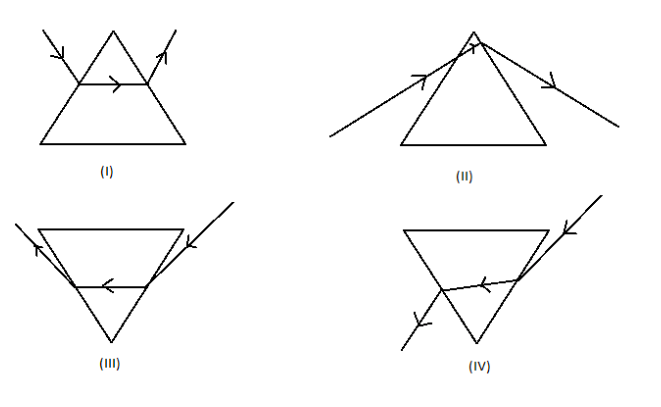
Answer
421.8k+ views
Hint:-To solve these kinds of problems we should apply the basic principles of behavior of light rays when it passes through different kinds of mediums like denser and rarer mediums. So, here we should check each diagram that it follows the basic laws of tracing.
Step by step complete solution:-To trace the path of ray of light through prism we should remember two basic laws that-
(a) When light goes from rarer medium to denser medium, it bends towards normal.
(b) When light goes from a denser medium to rarer medium, it bends away from normal.
Here we know that the medium inside prism is denser and outside is rarer.
Now we should check each given option for these two conditions.
For option (1), The incident ray when enters into the prism(Denser medium) then it bends away from the normal line on the left surface of the prism. So it violates the laws.
For option (2), The incident ray does not show any effect of medium when passes through left side of prism( Rarer to denser medium)
For option (3), Incident ray is coming from the right side of the prism. When it enters into the prism, the ray bends towards normal and when it comes out from the prism it bends away from the normal to the left side of the prism.
So option (3) fulfills the conditions that when light goes from rarer medium to denser medium, it bends towards normal and when light goes from a denser medium to rarer medium, it bends away from normal.
So option (3) shows the correct path of ray passing through prism.
Note:-Sometimes, we don’t focus on the direction of the incident line and apply all the basic principles correctly. But the final answer goes wrong because of the mistake in observing the right direction of the incident ray.
Step by step complete solution:-To trace the path of ray of light through prism we should remember two basic laws that-
(a) When light goes from rarer medium to denser medium, it bends towards normal.
(b) When light goes from a denser medium to rarer medium, it bends away from normal.
Here we know that the medium inside prism is denser and outside is rarer.
Now we should check each given option for these two conditions.
For option (1), The incident ray when enters into the prism(Denser medium) then it bends away from the normal line on the left surface of the prism. So it violates the laws.
For option (2), The incident ray does not show any effect of medium when passes through left side of prism( Rarer to denser medium)
For option (3), Incident ray is coming from the right side of the prism. When it enters into the prism, the ray bends towards normal and when it comes out from the prism it bends away from the normal to the left side of the prism.
So option (3) fulfills the conditions that when light goes from rarer medium to denser medium, it bends towards normal and when light goes from a denser medium to rarer medium, it bends away from normal.
So option (3) shows the correct path of ray passing through prism.
Note:-Sometimes, we don’t focus on the direction of the incident line and apply all the basic principles correctly. But the final answer goes wrong because of the mistake in observing the right direction of the incident ray.
Recently Updated Pages
How many sigma and pi bonds are present in HCequiv class 11 chemistry CBSE

Mark and label the given geoinformation on the outline class 11 social science CBSE

When people say No pun intended what does that mea class 8 english CBSE

Name the states which share their boundary with Indias class 9 social science CBSE

Give an account of the Northern Plains of India class 9 social science CBSE

Change the following sentences into negative and interrogative class 10 english CBSE

Trending doubts
Difference between Prokaryotic cell and Eukaryotic class 11 biology CBSE

Which are the Top 10 Largest Countries of the World?

Differentiate between homogeneous and heterogeneous class 12 chemistry CBSE

Fill the blanks with the suitable prepositions 1 The class 9 english CBSE

Difference Between Plant Cell and Animal Cell

Give 10 examples for herbs , shrubs , climbers , creepers

The Equation xxx + 2 is Satisfied when x is Equal to Class 10 Maths

Write a letter to the principal requesting him to grant class 10 english CBSE

Change the following sentences into negative and interrogative class 10 english CBSE




